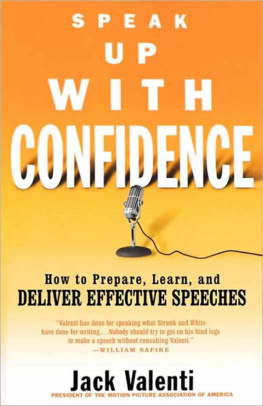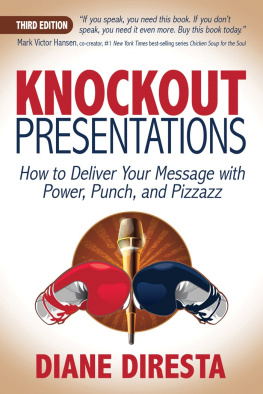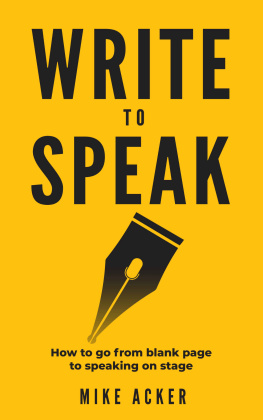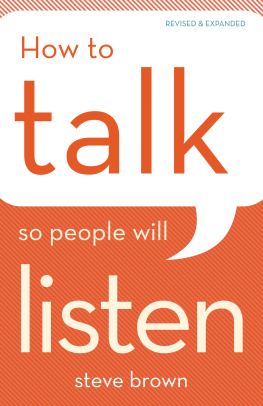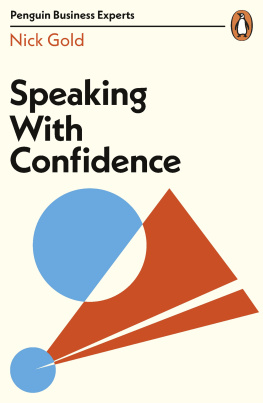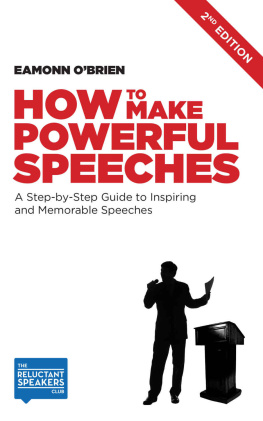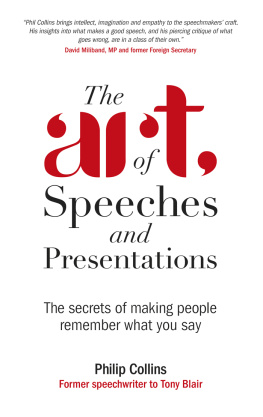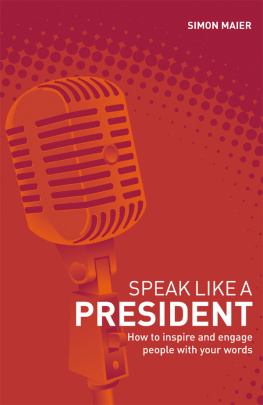ALL MY LIFE I have been fascinated with the art of public persuasion, or what most of us describe as public speaking.
When I was ten years old I made my first speech in front of an audience. My father was pleased with my babblings at family gatherings and claimed that I had some talent for speaking. So one evening at a political rally in Houston, Texas, for the reelection of the current sheriff of Harris County, my father told me to say some nice words about the sheriff. He lifted me up on the speakers rostrum (the rear of a flatbed truck) and the emcee put me on. I have no recollection of what I said that warm Houston evening, except I do remember the sheriff, T. A. Binford, a huge bulk of a man who ranged upward to six feet three. He wore shining brown cowboy boots and carried on his hips two pearl-handled .45s, slung low, just like those movie gunfighters in the Old West.
If you were about to commit some naughty crime, you had best do it in some jurisdiction other than Harris County. You just didnt want to mess with Sheriff Binford. His method of operation was Fire, Aim, Halt, in that order. The plain fact was, my father later confided, that Sheriff Binford was mighty pleased with my vocal endorsement. From that moment on, I found out that I truly enjoyed being on the speakers rostrum.
As I became more absorbed in being a clinical observer of countless speeches, presentations, and TV panel shows, I thought, Why not put what I had learned and absorbed about public speaking on paper? Maybe others would find it of some modest use. The result was this book, Speak Up with Confidence: How to Prepare, Learn, and Deliver Effective Speeches . It seemed to engage the interest of enough people to make the book a brief best-seller. Over the years, I kept meeting people in airports, at public functions, who offered their gratitude for my book and told me how it helped them when they were called on to speak up at some gathering.
More importantly, the environment and landscape for public dialogue has changed. The TelePrompTer is now omnipresenta staple at conventions, in television studioswhereas when my book first came out it had only sporadic influence. TV talk shows have proliferated. Panel discussions on television about science, economics, health, and civic enhancement have sprung up with the speed of rabbit warrens. More people are on their feet speaking at more conclaves in more cities and states than ever before.
Thus it is that I determined to bring Speak Up with Confidence up to the current moment, with new material, new observations, to give it new currency in a changing political, social, and cultural environment. However, the basic shape and form of preparing, learning, and delivering first-class public speeches and the labor required to achieve that goal remains the same.
Let us be clear: If you want to be able to rise before an audience, large or small, and speak to them so that they will listen to you, you can do it.
If you are a man or woman in business, college, in the professions; if you are interested in your community and choose to speak up from time to time to voice your concerns; if you are a public official or yearn to be one; if you are called upon to testify before Congress or your state legislature or your local city council, or your stockholders or employees; if you participate in civic clubs or other organizationsand you would like to become a competent public speaker, then this book is aimed at you. You can learn to speak better than you think possible.
I issue no guarantee that this book will teach you to become a great orator or a captivating speaker on TV. But I am very clearly and very specifically declaring that if you are willing to learn some simple rules, and apply those rules with personal discipline and concentrated work, you can achieve a level of professional competence in your speaking appearances that will lift your confidence and enthuse your spirit.
But there is a caveat. Nothing in this book will teach you anything unless you are willing to work hard. There is no magic word in this book. The magic comes from your own exertions, from the time, the discipline, and the commitment you put into the rules this book teaches you. Learning to speak well is no different from learning to ski or play the piano or rollerblade. You learn the basic rules, and then you practice. By the same token, you cant read this book and wake up in the morning a first-rate speaker.
Let me sum it up:
Learning to speak well demands work.
Work is the pathway to achievement.
Personal achievement will incite within you one of the most exciting emotions you can feel.
If this formula is congenial to you, then read on. Soon, very soon, you will be able to speak up with confidence.
The Beginning
Why You Must Know What You Are Going to Say
H e approached the rostrum looking no less than what he was, the commanding officer of one of the largest corporations in America. Tall, tending a touch toward portliness, firm of jaw and thick of hair, he dominated the others on the dais.
The audience, some thousand men and women in the Waldorf Astoria ballroom, waited expectantly for the words of a man they had been persuaded would offer them wisdom beyond their means about the future of the national economic landscape.
And then the blight began.
The corporate chief executives thick, usually confident fingers clutched the sides of the speakers lectern so as not to betray their trembling. He cleared his throat, and then, as a drowning man grabs a floating log, he leaped into the text before him, eyes fastened on the type-script, straining to keep jangling nerve ends from screeching loud enough to be heard by all in the room. For much of the speech all the audience saw was the top of his head.
The speech was a dud.
He droned when he should have talked. The confident, imperious manner that served him so well in boardrooms and staff meetings had fled. The speech he should have read over and over again to know it cold had lain unregarded in his briefcase for too long.
In short, this fine figure of a powerful business executive failed the test that ought to be applied to the leader of any enterprise: Can he stand before a group of people and persuade them, inspire them, and finally convince them?
It is a fact of life that too many people who ought to have developed some facility in speaking have done no such thing. How many public officials have you heard who seem to have brought dullness and droning to a high art?
If those who should speak well as part of their professional equipment cant do it, what about the vast majority of us who speak only occasionally? How can we be expected to do even passably well?
There is nothing really special about speaking in public. It is not a gift genetically inherited, nor is it divinely inspired. The truth is that speaking well before groups is a learnable craft, just as woodworking, skiing, playing the saxophone, ballroom dancing, gardening, sex, or roller-skating are all learned.
Stage fright? Its nothing to be ashamed of. Even the most seasoned professionals are affected by it. Actors and actresses, who make their living by performing for others, are not immune to the clammy embrace of fear. Some great actors claim that fear is a stimulant, alerting the mind and the tongue, rousing the nerve centers to a fine sensitivity, tuned to the moments duty. Total relaxationfearlessness, if you willcan often be delusive, slackening the responses, loosening the very fibers that ought to be taut and ready. Stage fright, then, is a spur to achievement. It is a good sign, not a bad one.

